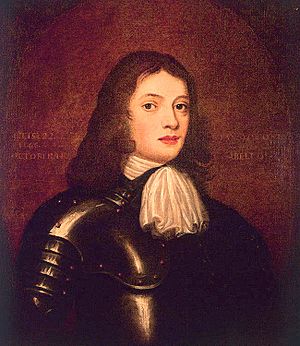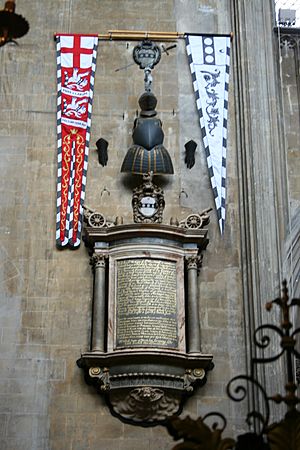William Penn (Royal Navy officer) facts for kids
Quick facts for kids
Sir William Penn
|
|
|---|---|

Admiral Sir William Penn, 1621–1670 by Sir Peter Lely, painted 1665–1666, part of the Flagmen of Lowestoft series
|
|
| Born | 23 April 1621 St. Thomas Parish, Bristol, England |
| Died | 16 September 1670 (aged 49) Walthamstow, England |
| Allegiance | |
| Service/ |
|
| Rank | Admiral |
| Commands held | Jamaica Station |
| Battles/wars | English Civil War First Anglo-Dutch War Second Anglo-Dutch War |
| Signature | |
Sir William Penn (born April 23, 1621 – died September 16, 1670) was an important English admiral (a high-ranking naval officer) and politician. He was a member of the House of Commons, which is like a part of the government, from 1660 to 1670. He is also famous for being the father of William Penn, who founded the colony of Pennsylvania in America. Today, Pennsylvania is one of the United States.
Contents
Early Life and Family
William Penn was born in Bristol, England. His parents were Giles Penn and Joan Gilbert. He learned about life at sea by working with his father from a young age.
Later, on June 6, 1643, he married Margaret Jasper. She was the daughter of a rich merchant from Rotterdam. They had three children together:
- William Penn (1644–1718), who later founded Pennsylvania.
- Margaret "Pegg" Penn.
- Richard Penn.
Sir William Penn had a long and active career in the navy. He fought in several important wars.
Fighting in the English Civil War
During the First English Civil War (1642–1646), Penn supported the Roundheads. The Roundheads were on the side of Parliament, fighting against King Charles I. Penn commanded a ship that patrolled the seas around Ireland. This job was tough and needed a skilled sailor.
In 1648, he was briefly arrested in London. However, he was soon released and sent back to sea as a rear-admiral. The exact reason for his arrest is not fully known. It's thought he might have been suspected of talking with the King's supporters.
Chasing Royalists and First Dutch War
After 1650, Penn became the commander of the southern fleet. He sailed in the Atlantic Ocean and the Mediterranean Sea. His mission was to chase after the Royalists, who were supporters of the King. These Royalists were led by Prince Rupert. Penn was very busy during this time. When he returned home in 1651, he had not stepped on land for over a year!
Penn also played a big part in the First Anglo-Dutch War (1652–1654). This was a conflict between England and the Dutch Republic. He led groups of ships in several major battles, including:
- Battle of the Kentish Knock (1652)
- Battle of Portland (1653)
- Battle of the Gabbard (1653)
- Battle of Scheveningen (1653)
In the Battle of Scheveningen, a soldier from Penn's ship shot and killed the Dutch admiral, Maarten Tromp.
Expedition to the West Indies
In 1654, Penn was given command of a naval expedition to the West Indies. This trip was ordered by Oliver Cromwell, who was then the leader of England. In 1655, Penn's fleet tried to attack La Hispaniola (an island in the Caribbean). The attack did not go well because the soldiers panicked.
However, after this, English forces successfully took control of the island of Jamaica. This island was less desirable than Hispaniola, but it became an important base for the English navy. This base was called the Jamaica Station.
When Penn returned to England, he and his army colleague, Robert Venables, were sent to the Tower of London. This was a famous prison. Penn apologized for the failed attack. After he was released, he went to live on land he had received in Ireland. In 1658, he was made a knight, but this honor was later removed when the King returned to power.
Political Career and Restoration
In April 1660, William Penn was chosen to be a Member of Parliament for Weymouth and Melcombe Regis. He was part of the Convention Parliament. He helped bring King Charles II back to England from exile. This event is known as the Restoration.
In May 1660, Penn was on the ship Naseby (later renamed the Royal Charles). This ship brought King Charles II home from Amsterdam. During this journey, Penn met the Duke of York, who would soon become the Lord High Admiral. Penn had a lasting influence on the Duke.
In 1661, Penn was re-elected to Parliament. In the Second Anglo-Dutch War, he was a flag captain at the Battle of Lowestoft in 1665. He served under James, Duke of York. Later that year, even though he was suffering from gout (a painful joint condition), he led one of the fleets sent to stop the Dutch admiral Michiel de Ruyter.
Penn's Legacy and Impact
Sir William Penn was very important in the history of the English navy. As an admiral for Parliament, he helped create the first set of tactics for the English navy in 1653. These rules were called Duties of a Commander at Sea, 1664, Instructions by Sir W. Penn. They became the basis for the "Duke of York's Sailing and Fighting Instructions," which guided the navy's tactics for a long time. Penn was one of the first to suggest fighting in a "line ahead" formation. This meant ships would line up one behind the other to use all their cannons at once.
A lot of what we know about Penn's adult life comes from the diary of Samuel Pepys. Pepys worked with Penn at the Navy Board and was his neighbor. Pepys sometimes wrote negative things about Penn, but he also recognized Penn's skills. For example, on July 4, 1666, Pepys wrote that Penn talked "very rationally" about lessons learned from a battle. He said he enjoyed hearing Penn speak more than ever before.
Sir William Penn is buried in the church of St Mary Redcliffe in Bristol, his hometown. His helmet and armor are displayed on the wall there. You can also see tattered flags from Dutch ships he captured in battle. His portrait, painted by Lely, is in the Painted Hall at Greenwich.
After Sir William Penn died, the King owed his family money. Instead of money, his son, also named William Penn, accepted a large piece of land in the American colonies. William Penn wanted to call the land "New Wales." However, a Welsh government official objected. So, William Penn suggested "Sylvania," which means "forest land." The King's council then added "Penn" to the name to honor Sir William Penn, his father. William Penn at first didn't want this, but he eventually accepted it.

Images for kids
-
Admiral Sir William Penn, 1621–1670 by Sir Peter Lely, painted 1665–1666, part of the Flagmen of Lowestoft series






